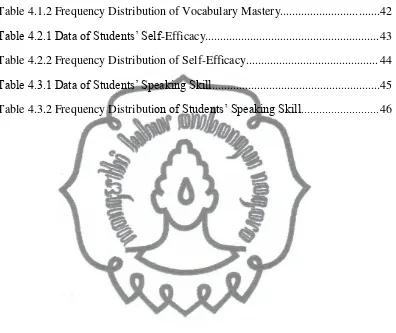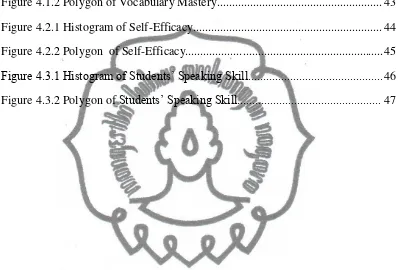commit to user
A CORRELATIONAL STUDY ON VOCABULARY MASTERY,
SELF-EFFICACY, AND STUDENT’S SPEAKING SKILL
(A Correlational Study on Vocabulary Mastery, Self-Efficacy, and Students’ Speaking Skill of the Eleventh Grade Students of SMA Negeri 6 Surakarta in
the Academic Year of 2013/2014)
A THESIS
By:
LATHIFA NUR RIZKA HIDAYAH
K2209053
TEACHER TRAINING AND EDUCATION FACULTY
SEBELAS MARET UNIVERSITY
SURAKARTA
commit to user
commit to user
iii
A CORRELATIONAL STUDY ON VOCABULARY MASTERY,
SELF-EFFICACY, AND STUDENT’S SPEAKING SKILL
(A Correlational Study on Vocabulary Mastery, Self-Efficacy, and Students’ Speaking Skill of the Eleventh Grade Students of SMA Negeri 6 Surakarta in
the Academic Year of 2013/2014)
By:
LATHIFA NUR RIZKA HIDAYAH
K2209053
A THESIS
Submitted to the Teacher Training and Education Faculty of Sebelas Maret University to Fulfill on of the Requirements for Achieving Undergraduate
Degree of Education in English
TEACHER TRAINING AND EDUCATION FACULTY
SEBELAS MARET UNIVERSITY
SURAKARTA
commit to user
commit to user
commit to user
vi ABSTRACT
Lathifa Nur Rizka Hidayah. 2013. A Correlational Study on Vocabulary Mastery, Self-Efficacy, and Students’ Speaking Skill of the Eleventh Grade Students of SMA Negeri 6 Surakarta in the Academic Year of 2013/2014. English Education Department. Teacher Training and Education Faculty of Sebelas Maret University. Surakarta. 2014.
The objectives of the study are to determine the correlation between (1) vocabulary mastery and students’ speaking skill; (2) self-efficacy and students’ speaking skill; and (3) vocabulary mastery, self-efficacy, and students’ speaking skill; and to predict the contribution of vocabulary mastery and self-efficacy toward speaking skill.
This study used correlational study. It is carried out in September 2013 at SMA Negeri 6 Surakarta. The population of this study was all the eleventh grade students of SMA Negeri 6 Surakarta which consists of ten classes. The total number of the students was 276 students. The sample for this study was 34 students taken by cluster random sampling technique. The instruments for collecting the data were questionnaire and test. Questionnaire was used to collect the data of self-efficacy and test was used to collect the data of vocabulary and speaking skill. The techniques which were used to analyze the data were Simple Correlation and Multiple Regression Correlation.
The results of the data analysis show that at the level of significance α =
0.05 (1) there is a positive correlation between vocabulary mastery and students’
speaking skill (rx1y = 0.481 > rt = 0.339); (2) there is a positive correlation between self-efficacy and students’ speaking skill (rx2y = 0.386 > rt = 0.339); (3) there is a positive correlation between vocabulary mastery, self-efficacy, and
students’ speaking skill (Ry12 = 0.861 and Fo = 44.57 > Ft = 3.32).
According to the result of the study, it is found that there is a positive correlation between vocabulary mastery and students’ speaking skill; there is a positive correlation between self-efficacy and students’ speaking skill; and there is a positive correlation between vocabulary mastery, self-efficacy simultaneously
and students’ speaking skill of the eleventh grade students of SMA Negeri 6 Surakarta in the academic year of 2013/2014.
The result of the study shows that vocabulary mastery and self-efficacy are predictors which give a contribution to students’ speaking skill as many as 29.94%. So, both vocabulary mastery and self-efficacy are one of the important
factors that should be considered in improving students’ speaking skill.
commit to user
vii ABSTRAK
Lathifa Nur Rizka Hidayah. 2013. A Correlational Study on Vocabulary Mastery, Self-Efficacy, and Students’ Speaking Skill of the Eleventh Grade Students of SMA Negeri 6 Surakarta in the Academic Year of 2013/2014. Pendidikan Bahasa Inggris. Fakultas Keguruan dan Ilmu Pendidikan Universitas Sebelas Maret. Surakarta. 2014.
Penelitian ini bertujuan untuk mengetahui hubungan antara (1) penguasaan kosakata dan kemampuan berbicara bahasa Inggris; (2) self-efficacy dan kemampuan berbicara bahasa Inggris; dan (3) penguasaan kosakata, self-efficacy, terhadap kemampuan berbicara bahasa Inggris; dan untuk memprediksi kontribusi penguasaan kosakata, dan self-efficacy terhadap kemampuan berbicara bahasa Inggris siswa.
Penelitian ini menggunakan metode korelasi dan telah dilaksanakan pada bulan September di SMA Negeri 6 Surakarta. Populasi penelitian ini adalah seluruh siswa kelas sebelas SMA Negeri 6 Surakarta berjumlah 276 orang siswa. Sampel penelitian ini berjumlah 34 orang siswa yang diambil menggunakan metode cluster random sampling. Instrumen yang digunakan untuk mengumpulkan data adalah kuesioner dan tes. Kuesioner digunkan untuk mengumpulkan data self-efficacy dan tes digunakan untuk mengumpulkan data penguasaan kosakata dan kemampuan berbicara bahasa Inggris. Teknik yang digunakan untuk menganalisis data adalah Simple Correlation and Multiple
Regression Correlation.
Analisis data menunjukkan pada level signifikansi α = 0.05, terdapat korelasi positif antara (1) penguasaan kosakata dan kemampuan berbicara bahasa Inggris (rx1y = 0.481 > rt = 0.339); (2) self-efficacy dan kemampuan berbicara bahasa Inggris (rx2y = 0.386 > rt = 0.339); (3) penguasaan kosakata dan
self-efficacy terhadap kemampuan berbicara bahasa Inggris siswa (Ry12 = 0.861 and Fo
= 44.57 > Ft = 3.32).
Berdasarkan hasil penelitian, ditemukan adanya (1) korelasi positif antara penguasaan kosakata dan kemampuan berbicara bahasa Inggris; (2) korelasi positif antara self-efficacy dan kemampuan berbicara bahasa Inggris; (3) korelasi positif antara penguasaan kosakata dan self-efficacy terhadap kemampuan berbicara bahasa Inggris siswa kelas sebelas SMA Negeri 6 Surakarta tahun akademik 2013/2014.
Hasil penelitian menunjukkan bahwa penguasaan kosakata dan
self-efficacy memberikan kontribusi sebanyak 29.94% terhadap kemampuan berbicara
bahasa Inggris siswa dan merupakan faktor yang dapat dipertimbangkan dalam usaha meningkatkan kemampuan berbicara bahasa Inggris siswa.
commit to user
viii MOTTO
“...Allah does not change a people’s lot unless they change what is in their hearts...” (Q.S. Ar-Ra’d : 11)
“Man Jadda wa Jada” (Arabic Proverb)
“Always bear in mind that your own resolution to succeed is more important than
any other” (Abraham Lincoln)
commit to user
ix
DEDICATION
This Thesis is dedicated to:
My beloved Mom and Dad
My beloved sister and brother
commit to user
x
ACKNOWLEDGMENT
Alhamdulillah, all the praises just be for Allah SWT, the Almighty and
Merciful God, for giving blessing, guidance, mercy, health, and strength to the
researcher in doing and finishing this thesis. In doing and finishing the thesis, the
researcher also received support, advice, and assistance from many people.
Therefore, the researcher would like to say her gratitude towards people who give
contribution to finish this thesis:
1. The Dean of Teacher Training and Education Faculty
2. The Head of English Department, Endang Setyaningsih, S.Pd., M.Hum.
3. Drs. Gunarso Susilohadi, M.Ed TESOL, as the first consultant for his time,
guidance, advice, and suggestions.
4. Drs. A. Handoko Pudjobroto, as the second consultant for his time,
suggestions, guidance, and advice.
5. Kristiandi, M.A., as the academic consultant for his time, guidance, and
advice.
6. All lecturers in English Education Department for all the the precious
knowledge and guidance.
7. The Headmaster of SMA Negeri 6 Surakarta for her permission to conduct
the research.
8. Drs. Ahmad Al Adib for his guidance during the research.
9. The students of class XI IPS 1, XI IPS 2, and XI IPS 3 for cooperating
during the research.
10.Her beloved parents, sister, and brother, for their love, support, and
motivation so that the thesis can be finished.
11.Shelia, Fufu, Fifi, Sita, Winda, Resty, Alvi, Lisa, and all her friends in
English Department 2009 for their friendship, motivation, support, love,
commit to user
xi
12.Her seniors in English Department for their motivation, advice, and
suggestions.
13.Dita, Ais, Nisa, Ira, Fitri, and all friends in “Kost Cinta Damai” for their
love, support, and motivation.
14.The big family of LPM Motivasi for all lovely moments and experiences,
support, friendship, and togetherness.
15.The big family of Solo Mengajar, especially volunteers and kids at Taman
Cerdas Mojosongo for the unforgettable experience and moments.
Surakarta, Desember 2013
commit to user
xii
TABLE OF CONTENTS
TITLE... i
PRONOUNCEMENT... ii
SUBMISSION... iii
APPROVAL OF THE CONSULTANTS... iv
APPROVAL OF THE THESIS EXAMINERS... v
ABSTRACT... vi
MOTTO... vii
DEDICATION... viii
ACKNOWLEDGMENT... . x
TABLE OF CONTENT... xii
LIST OF TABLE... xv
LIST OF FIGURE... xvi
LIST OF APPENDICES... xvii
CHAPTER I: INTRODUCTION A. Background of the Study... 1
B. Problem Identification... 5
C. Problem Limitation... 5
D. Formulation of the Problem... 6
E. Objectives of the Study... 6
F. Benefits of the Study ... 7
CHAPTER II: REVIEW OF RELATED LITERATURE A. Review on Speaking Skill... 8
1. The Definition of Speaking Skill... 8
commit to user
xiii
3. Speaking Activity Problem... 12
4. A Successful Speaking Activity... 13
B. Review on Vocabulary Mastery... 14
1. The Definition of Vocabulary Mastery... 14
2. The Importance of Vocabulary Mastery... 15
3. Types of Vocabulary... 16
4. Aspects of Vocabulary... 17
C. Review on Self-Efficacy... 20
1. The Definition of Self-Efficacy... 20
2. Sources of Self-Efficacy... 21
3. The Importance of Self-Efficacy in Language Learning... 22
D. Rationale... 23
E. Hypotheses... 25
CHAPTER III: RESEARCH METHODOLOGY A. The Place and Time of Research... 26
B. The Method of Research... 26
C. The Subject of the Research... 28
1. Population... 28
2. Sample... 28
3. Sampling... 28
E. Technique of Collecting Data... 29
1. The Instrument of Collecting the Data... 29
a. Questionnaire... 29
b. Test... 30
2. Try Out of the Instruments... 32
commit to user
xiv
b. The Reliability of the Instrument... 33
F. Technique of Analyzing Data... 35
1. Prerequisite Test... 35
a. Normality Test... 35
b. Linearity and Significance of Regression... 35
2. Hypothesis Testing... 37
CHAPTER IV: RESULT OF THE STUDY A. The Data Description... 41
1. The Data of Vocabulary Mastery... 41
2. The Data of Self-Efficacy... 43
3. The Data of Speaking Skill... 45
B. The Testing of Pre-requirement Analysis... 47
1.Normality Test... 47
2.Linearity and Significance of Regression Test... 48
C. Hypotheses Testing... 49
D. Discussion of Research Finding... 52
CHAPTER V: CONCLUSION, IMPLICATION, AND SUGGESTION A. CONCLUSION... 56
B. IMPLICATION... 57
C. SUGGESTION... 58
BIBLIOGRAPHY ... 60
commit to user
xv
LIST OF TABLE
Table 4.1.1 Data of Vocabulary Mastery... 41
Table 4.1.2 Frequency Distribution of Vocabulary Mastery... 42
Table 4.2.1 Data of Students’ Self-Efficacy... 43
Table 4.2.2 Frequency Distribution of Self-Efficacy... 44
Table 4.3.1 Data of Students’ Speaking Skill... 45
commit to user
xvi
LIST OF FIGURE
Figure 3.1 Diagram of Relationship of the Variables... 27
Figure 4.1.1 Histogram of Vocabulary Mastery... 42
Figure 4.1.2 Polygon of Vocabulary Mastery... 43
Figure 4.2.1 Histogram of Self-Efficacy... 44
Figure 4.2.2 Polygon of Self-Efficacy... 45
Figure 4.3.1 Histogram of Students’ Speaking Skill... 46
commit to user
xvii
LIST OF APPENDICES
Appendix 1 List of Students Joining Try Out... 64
Appendix 2 List of Students Joining the Test... 65
Appendix 3a The Blueprint of Vocabulary Mastery (Try Out)... 65
Appendix 3b The Instrument of Vocabulary Mastery (Try Out)... 68
Appendix 3c The Answer Key of Vocabulary Mastery (Try Out)... 76
Appendix 4a The Blueprint of Self-Efficacy (Try Out)... 78
Appendix 4b The Instrument of Self-Efficacy (Try Out)... 80
Appendix 4c The Answer Key of Self-Efficacy (Try Out)... 86
Appendix 5 Student’s Worksheet of Vocabulary Mastery (Try Out)... 87
Appendix 6 Student’s Worksheet of Self-Efficacy (Try Out)... 102
Appendix 7a Validity and Reliability Table of Vocabulary Mastery... 114
Appendix 7b Validity and Reliability Table of Self-Efficacy... 121
Appendix 7c Computation of Validity Test... 126
Appendix 8 Computation of Reliability Test... 128
Appendix 9a The Blueprint of Vocabulary Mastery (Take Data)... 129
Appendix 9b The Instrument of Vocabulary Mastery (Take Data)... 130
Appendix 9c The Answer Key of Vocabulary Mastery (Take Data)...134
Appendix 10a The Blueprint of Self-Efficacy (Take Data)... 135
Appendix 10b The Instrument of Self-Efficacy (Take Data)...137
Appendix 10c The Answer Key of Self-Efficacy (Take Data)... 142
Appendix 11 Student’s Worksheet of Vocabulary Mastery (Take Data)... 143
Appendix 12 Student’s Worksheet of Self-Efficacy... 151
Appendix 13 Scoring Rubric Speaking... 161
commit to user
xviii
Appendix 15 Data Distribution of Each Variable... 171
Appendix 16 Normality Test... 173
Appendix 17 Linearity and Significance Regression Test... 176
Appendix 18 Analysis of Single Correlation... 182
Appendix 19 Analysis of Multiple Regressions and Multiple Correlations... 186
Appendix 20 r- table... 190
Appendix 21 Standard Normal Distribution-table... 191
Appendix 22 Liliefors-table... 192
Appendix 23 t-table... 193
Appendix 24 F-table... 194

